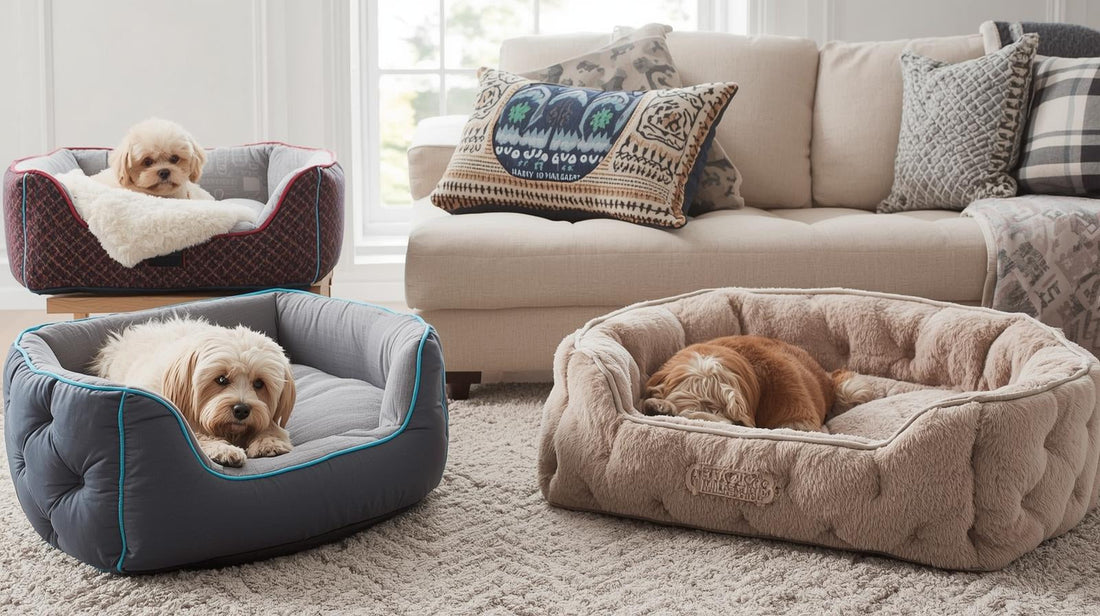
How to Choose the Perfect Bed for Your Pet
Share
Finding the perfect pet bed is more than just buying a cushion for your furry companion. It’s about giving them comfort, warmth, and a space they can truly call their own. Whether you’re shopping for a dog bed that supports an aging Labrador or a cat bed that keeps your feline cozy and secure, choosing the right bed can make all the difference in your pet’s quality of life.
This guide will help you navigate the world of pet beds — from size and material to design and special features — so you can choose the ideal sleeping spot for your four-legged friend.
Why Choosing the Right Pet Bed Matters
A high-quality pet bed is essential for your animal’s health and happiness. Just like humans need supportive mattresses, pets rely on their beds for rest and joint support. A properly chosen dog bed or cat bed can prevent stiffness, improve sleep quality, and provide emotional comfort.
For dogs, the right bed reduces stress and supports healthy posture. For cats, it offers a sense of security and warmth — especially important since felines are naturally territorial and enjoy cozy, enclosed spaces.
Plus, having a designated pet bed keeps your furniture cleaner and gives your pet a sense of belonging within your home.
Understanding Your Pet’s Sleeping Style
Observe Their Preferred Sleeping Positions
Every animal has unique sleeping habits that affect the type of pet bed they’ll love most. Some dogs stretch out like athletes after a long run, while others curl tightly into a ball. Cats often sleep curled up or tucked into corners.
If your pet likes to stretch out, a rectangular dog bed or large pet mattress gives them room to sprawl. Curlers and cuddlers prefer round or donut-shaped beds with raised edges for comfort. Cats often love hooded or cave-style beds that give them privacy.
Consider Their Age and Health
Puppies, kittens, and senior pets have different needs. Young animals might need soft, cozy beds for security, while older pets benefit from orthopedic pet beds that relieve pressure on joints and muscles.
If your dog or cat has arthritis or hip dysplasia, memory foam beds are especially helpful because they contour to the body and offer extra support.
Getting the Right Size Pet Bed
Measure for the Perfect Fit
To choose the right pet bed size, measure your pet from nose to tail when they’re stretched out and add a few inches for comfort. A bed that’s too small can make your pet feel cramped, while one that’s too large may not provide the snugness they crave.
For puppies and kittens, you can size up slightly to accommodate growth.
Match Size to Breed and Weight
Small breeds and cats often love compact beds that make them feel secure. Medium dogs, like Beagles or Bulldogs, prefer medium-sized beds with moderate cushioning. Large dogs, such as Labradors or Golden Retrievers, need large dog beds with firm, supportive foam to prevent sagging.
Different Types of Pet Beds
1. Cushion or Pillow Beds
These classic pet beds are simple yet versatile. They offer a soft surface for dogs and cats who like to sprawl out. Available in many fabrics and fillings, they’re easy to move around and work well for most indoor pets.
2. Bolster or Sofa Beds
Bolster-style beds have raised sides, offering head and neck support — ideal for pets that like to lean or snuggle. A bolster dog bed or cat sofa bed gives a sense of security while still offering comfort and style.
3. Orthopedic Pet Beds
Perfect for older dogs and cats, orthopedic beds use high-density or memory foam to support joints and relieve pain. These beds are especially beneficial for breeds prone to hip or joint problems, offering therapeutic comfort that improves sleep and mobility.
4. Heated and Cooling Beds
Temperature control can make a big difference. A heated pet bed provides cozy warmth in winter, while cooling beds with gel-infused foam help pets stay comfortable during hot weather. Cats especially enjoy heated beds that mimic body warmth.
5. Cave and Enclosed Beds
If your cat or small dog prefers privacy, a cave-style pet bed or hooded bed is perfect. These mimic dens and help shy pets feel safe.
6. Elevated Beds
Elevated pet beds sit off the ground, improving airflow and keeping your pet dry and cool. They’re great for outdoor spaces or for pets who overheat easily.
Choosing the Best Material for Your Pet Bed
Fabric Choices
The exterior fabric of your pet bed affects comfort, cleaning ease, and durability. Soft fleece or microfiber provides warmth and coziness, while canvas and denim are ideal for heavy chewers. If your pet sheds a lot, choose tightly woven fabrics like nylon, which resist fur and are easy to clean.
Filling and Cushioning
Polyester fill creates a plush feel, but memory foam or orthopedic foam offers long-lasting support. Look for a washable pet bed with removable covers and waterproof linings to simplify maintenance — especially for puppies or senior pets.
Eco-conscious pet owners can opt for organic cotton or recycled fiber fillings for a sustainable pet bed option.
Easy Cleaning and Maintenance
No matter how clean your pet is, accidents happen. Always choose a pet bed with a removable, machine-washable cover. Waterproof liners protect against spills or accidents.
If your dog loves the outdoors, look for water-resistant or mud-proof fabrics. For cats, opt for a cat bed that can handle fur and frequent washing without losing shape.
Where to Place the Pet Bed
Placement affects how much your pet uses their bed. Most dogs prefer a quiet but social area — perhaps a corner of the living room where they can see the family but still relax. Cats prefer sunny spots, windowsills, or cozy corners away from foot traffic.
Avoid placing the bed in cold, drafty areas or under direct sunlight. You can even have multiple beds around your home so your pet always has a comfortable place to rest.
Dog Beds vs. Cat Beds
Dog Beds: Comfort and Support
Dogs need a bed that supports their weight, cushions their joints, and helps regulate temperature. Large breeds may prefer flat, orthopedic mattresses, while small dogs love soft, donut-style beds.
Breeds prone to joint issues — like German Shepherds or Labradors — greatly benefit from orthopedic dog beds that reduce pressure and improve circulation.
Cat Beds: Warmth and Security
Cats sleep up to 16 hours a day, so the right cat bed is essential. They love warmth and privacy, so enclosed or self-warming beds are ideal. Cats also enjoy elevated spaces — window hammocks or tower beds give them the comfort and vantage points they crave.
Eco-Friendly and Sustainable Pet Bed Options
If you’re environmentally conscious, consider a sustainable pet bed made from organic cotton, bamboo, or recycled materials. Many eco-friendly brands also make refillable beds, so you can replace the stuffing without discarding the entire bed.
These options reduce waste while keeping your furry companion comfortable.
Special Features to Look For
Modern pet beds include thoughtful features for added convenience and safety. Non-slip bottoms prevent sliding on hardwood floors, while travel-friendly models fold easily for car rides or camping trips.
Some orthopedic pet beds come with dual layers — a cooling gel top and supportive foam base — to keep pets comfortable year-round.
How to Introduce a New Bed to Your Pet
Even the coziest pet bed might take some getting used to. Encourage your pet by placing the bed in their favorite resting spot and adding a familiar blanket or toy. You can even use treats or praise to create positive associations.
Over time, your pet will naturally gravitate toward their new bed — and you’ll notice they’re sleeping more soundly.
When to Replace a Pet Bed
All beds wear out eventually. If your dog bed or cat bed has flattened, torn, or lost its shape, it’s time for a replacement. A lumpy or sagging bed can cause discomfort and joint strain, especially for senior pets.
Watch for signs like your pet avoiding the bed or constantly shifting positions — these are cues that it’s no longer providing proper support.
Final Thoughts: Comfort, Care, and Companionship
Choosing the perfect pet bed is an investment in your pet’s happiness and health. The right bed supports their body, soothes their mind, and gives them a safe place to unwind.
When you select a high-quality dog bed or cat bed that fits your pet’s size, age, and sleeping habits, you’re not just improving their rest — you’re strengthening the bond you share.
A well-rested pet is a happier, healthier companion, and that’s something every pet owner can feel good about.
